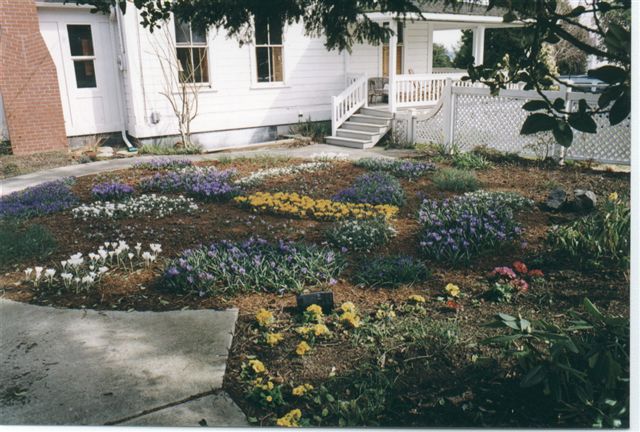THE CROCUS PROJECT
CATEGORY: PORT TOWNSEND HOUSE
PHOTOS: CROCUS CIRCLE, FIRST AND ONLY YEAR


The last fall that I lived in my Port Townsend house, I planted 2600 crocus bulbs in the circle in my back yard. By then Don Stalter and I had become a couple and he helped me. First, we amended the soil with sand and compost. We planted the bulbs in swaths of different colors. When they were all tucked in place under the ground, we over-planted them with various low-growing, evergreen ground covers, also in various colors: dark green, bright green, yellow green, gray green. The most notable and vigorous of these was a creeping chamomile: chamaelelum trenegue which I had found at a nursery in Sequim where it had naturalized and was growing all over the ground like a weed. It was lush and bright green.
I tried to explain about the crocuses and the ground covers to the people who bought the house but, in my habitually inarticulate way, I didn’t do a very good job. I just assumed that they would know that crocuses bloom in February and are often planted in lawns for winter color—especially in England. And I didn’t explain that the ground covers would be better than a lawn, needing little water, being evergreen and only needing mowing once a year. At any rate, they didn’t want either. The back yard with the circle was the only part of the yard that was fenced. The new owners had just gotten two large puppies so they used that area as a dog yard. The newly amended soil was perfect for puppy digging. They later planted a lawn in the circle and later replaced that with pavers.
Before the puppies dug up the crocus bulbs, the owner told me I could come back and dig them up myself. I rescued as many as I could, but because I was then living in a rented house, I gave them all to Richard Terrill. He later had a problem with voles. The voles ate them all.
The crocus project was almost like Dadaism, an art movement that flourished in Europe during the First World War in which art was made and destroyed. The reward for our Dada garden was one season of something amazing, and then it lived in our memories for the rest of our lives.
